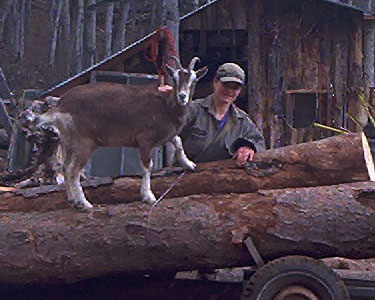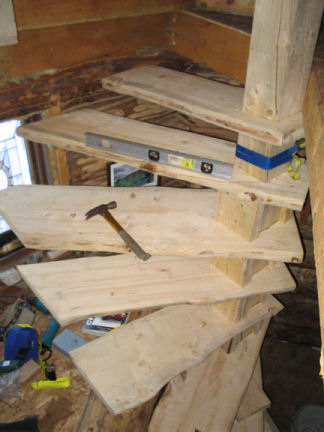Wood work
 Friday, November 20, 2009 at 9:17AM
Friday, November 20, 2009 at 9:17AM It might go without saying, but a healthy forest is essential to our way of life. There's not a day that goes by where we don't benefit from the trees on our place. When I was searching for raw, untouched land on which to build my homestead, an accessible woodlot was my number one criteria. There were other important options to be checked off the list, but wood was definitely right there at the top.
I made my way to in Alaska in 1991, and the spruce bark beetles had already nestled in to the extensive forests of the Kenai Peninsula. I worked my first two years down there on a wildland fire crew, mainly fighting fire in beetle infested areas. Then I got a job working trail crew for the Forest Service, maintaining foot trail through lots of spruce forest. We cleared trails of fallen timber, built boardwalks and bridges in remote areas using a backpacked chainsaw mill, and did alot of tread work.
Learning how to analyze a forest, harvest trees and turn them into building materials with very little equipment changed the way I look at the world. It gave me the ability to walk into a place and be able to create my own shelter... and its something no one can ever take away from me. Knowledge is power.

When I first started building, I had no trail to access the trees or the cabin site on my land. I backpacked my new saw and Alaska mill through the brush from spruce tree to spruce tree, and carried timbers and boards out by hand. Those were the days. These days we use machines to move logs to the mill, and other machines to move timbers to our homesite.
We rarely cut trees just for firewood. Most of our firewood comes as by-catch... lengths of log that aren't able to be used for building purposes, or "waste" from the building process. Almost all of our kitchenwood comes from slab- that half moon chunk of wood between the bark and the flat timber.
All of our cabins, both here and in the bush, are log-built with local trees. Floor boards and ceiling boards are carefully milled and planed. Trimmings go into the cookstove and shavings go into the chicken house. Outbuildings are often constructed with poles and slabwood. And fence-posts are usually peeled spruce trees that have been tarred.

Whoever said that heating with wood warms you over and over was right. Its alot of work harvesting trees, splitting lengths and hauling firewood. They say it warms you three times, but I think its more than that. Sometimes it seems like wood chores are endless.
When I was a kid I used to complain about having to move the woodpile. I guess that was before I had the life experience to understand how basic and gratifying it is to provide for yourself, and how essential wood is to our existence on the Frontier. Now I have to confess that I enjoy splitting wood, and the rest of the chores that go with it.
I love that we don't have to shop for furniture imported from some unknown part of the globe and constructed with questionable materials with lots of VOCs. Our beds and cabinets and tables and benches and shelves are all homemade. Birch makes especially fine furniture, but its not so easy to cure. It like to twist and turn as it dries. Cottonwood is also a hardwood, but it dries and shrinks for many years before becoming stable.
Primarily we use beetle-killed spruce, though its bounty is starting to dwindle. The trees that were killed by the beetles are now starting to rot beyond usefulness. But we've done a good amount of work, clearing out the dead trees over the last 14 years, and improving the forest. It feels good to know we've done our part, and our husbandry for the land shows through.

Now we're starting to clear an airstrip. Most of the trees in the flightpath are deciduous... almost all are birch or cottonwood or giant willow. So we'll be switching gears, building the new hangar with fresh leafy trees, instead of dead needled trees. I'm sure it will come with its own learning curve.
There's alot of pride that goes into building livable structures with wood off your place. It takes a ton of work, a good bit of practice, and not a little ingenuity to bring it all together. I'm so thankful I had the foresight to purchase property with a diverse and usable forest, and the experience to make it work for me. Without it, I might still be living in a tent, or squatting in someone else's cabin. Its great to be home.
 [Lisa Rae] |
[Lisa Rae] |  2 Comments |
2 Comments | 




















Reader Comments (2)
I was looking for goat shelter ideas and ran across this post. Sounds like a great life in Alaska enjoying nature and doing your part for the land. Thanks for sharing. I'd love to learn about that staircase picture. How did you get each slab to stay in place?
Hi Shad,
Each step is spaced on the "stalk" with 2'x8 blocks. The outside of the steps are fenced in with a rail, screwed into upright slabs.
Lisa